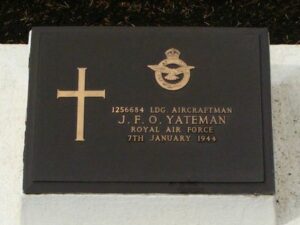Ardwyn Grammar School originally opened in 1896 as Aberystwyth County School, on the site of a private school called Ardwyn, which had been run by the Reverend Llewellyn Edwards, M.A. The name of the school changed several times over the coming years; its first change was to the Aberystwyth County School; from 1928, Ardwyn County School or Ardwyn School, and in line with the 1944 Education Act it was called Ardwyn Grammar School (although known locally as the County School). The school ceased to exist in 1973, after the comprehensive system was introduced. In 1973 Penglais School was formed, along with the first all-Welsh secondary school, sharing the Ardwyn premises for two years, until the English speaking pupils left for the Waun, and the whole of the old Ardwyn premises became an all Welsh comprehensive school named Penweddig. As a result of these changes of identity, the Great War Memorial is the Aberystwyth County School Memorial, whilst the World War Two Memorial is the Ardwyn Grammar School Memorial.
Aberystwyth County School, The Great War Roll of Honour
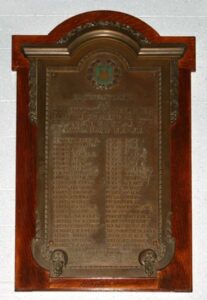
Robert Arthur Buttery, Second Lieutenant, Oxford and Bucks Light Infantry. Robert was the son of Robert William Buttery, and of Amy Caroline Buttery, of London. He was commissioned from the OTC into the 1st Battalion, Ox and Bucks Light Infantry on 19 December 1916. Robert was then posted to the 1/4th Battalion, Ox and Bucks Light Infantry, which was attached to 145 Brigade, 48th (South Midland) Division. In March 1917 the division followed the German Retreat to the Hindenburg Line, and later in the year fought at Third Ypres. The Division was ordered to Italy on 21 November 1917, remaining there for the duration of the war. Robert was killed in Italy on 15 June 1918. He was 27 years old, and is buried in Boscon British Cemetery, Italy.
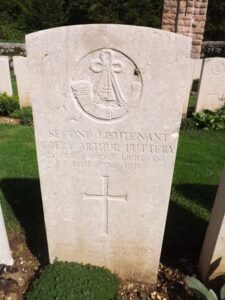
David John Brutus Davies, Bombardier, 86740, Canadian Field Artillery. David, better known to his Aberystwyth friends as Brutus, was born on 27 March 1887, the son of Hannah Davies and was educated at the County School in Aberystwyth before serving as an apprentice fitter and turner at the Rheidol Foundry. In 1910 he emigrated to Canada where he settled in Saskatchewan with his wife Ada. A former territorial with the Cardigan Battery he enlisted at Winnipeg on 29 December 1914 into the 5th Brigade, Canadian Field Artillery. The battery moved to France in the spring of 1915, and took up positions at Ypres. The Canadians took part in several major actions during 1915, and after another engagement at Mount Sorrel in June 1916 moved to the Somme. Here the Canadians fought at the battle of Flers-Courcelette, and the ensuing Battle of Thiepval. On 3 November 1916, Brutus, along with thirteen men of his company, were at sleep in a trench near Pozieres, when they were killed in their sleep by a German shell. David was 29 years old, and is buried in Pozières British Cemetery, France.
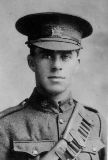
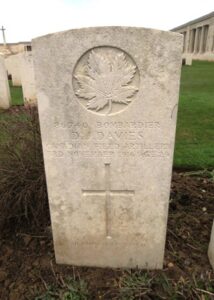
David Rees Davies, Sergeant, 14400, Kings Shropshire Light Infantry. David was the son of Aberystwyth Councillor David Davies, and of Eliza Jane Davies, and was employed at Lloyds Bank. He played football for Aberystwyth Town FC at centre forward. David joined the 7th Battalion, Kings Shropshire Light Infantry along with his close friend Edward David Evans on the same day in September 1914. The battalion was attached to 76 Brigade, 25th Division, and landed at Boulogne on 28 September 1915. On 15 October 1915 the Brigade moved to the 3rd Division, and on 19 October 1915 the battalion transferred to 8 Brigade in the same Division. In 1915 the Division saw action at Bellewaarde and Hooge, and took part in the Second attack on Bellewaarde. In 1916 the Division fought at the Actions of the Bluff, and at the St Eloi Craters. On 1 May 1916 David had volunteered to take up a forward position in the front line at Dickebusch. Sadly, the position was hit by shellfire, mortally wounding David. He died of his wounds that same day, before he could be taken to a dressing station. David was 23 years old, and is buried in La Clytte Military Cemetery, Belgium.
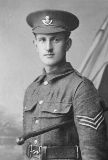
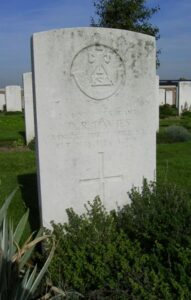
George Henry Davies, DCM, Sergeant, 52064, Cheshire Regiment. George was born in Aberystwyth in 1889, the son of John and Margaret Davies, of Pembroke House. He was educated at the County School, before enlisting at Holborn, London into the Royal Welsh Fusiliers. George was later transferred to the 13th Battalion, Cheshire Regiment, which was attached to 74 Brigade, 25th Division. George probably joined the Division after its move to the Warloy area, and took part in its attack on 3 July 1916 near Thiepval. The Division fought throughout the Battle of the Somme, and then moved to Ploegsteert, where it held the line for the months leading up the Battle of Messines in June 1917. George was killed in action by shellfire on 21 June 1917, just days after being awarded the Distinguished Conduct Medal for bravery. He was 28 years old, and is commemorated on the Ypres (Menin Gate) Memorial, Belgium.
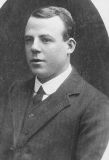
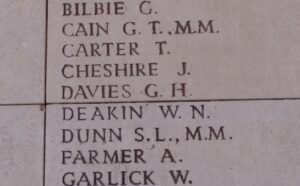
Henry Davies, Private, 48007, West Yorkshire Regiment. Henry was born at Llanbadarn, and enlisted at Hammersmith into the Army Service Corps. He served with their Motor Transport section for a while, before being sent to France in 1916, joining the 18th Battalion, West Yorkshire Regiment. The battalion formed at Bradford, as part of 93 Brigade, 31st Division, and moved to Egypt in December 1915. As the Gallipoli campaign was being closed down, the Division was diverted to France in March 1916, and saw its first major action at the Battle of Albert in July 1916. The Division took part in the assault on Serre, and suffered very high casualties, and was withdrawn for several months as a result, before moving back into the line in November 1916, before taking part in the Battle of the Ancre. The Division wintered on the Ancre, until moving to Arras the following year. Here they fought at the Third Battle of the Scarpe, and helped in the capture of Oppy Wood. Henry was killed in action here on 3 May 1917. He has no known grave, and is commemorated on the Arras Memorial, France.
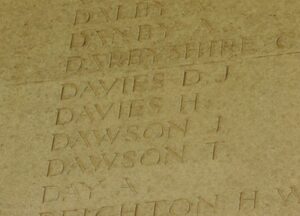
Thomas Davies, Private, 61573, Royal Army Medical Corps. Thomas was born in 1892, the son of David and Margaret Davies, of Preswylfa, Capel Sion, Llanbadarn. He resided at Porth prior to the war, and enlisted at Tylorstown into the Royal Army Medical Corps. Thomas arrived in Salonika on 15 September 1915, and was then attached to the 11th Battery, 1st Brigade, Royal Field Artillery. Thomas survived almost the whole campaign in Salonika, but took ill and died there on 10 November 1918, the day before the armistice. He was 26 years old, and is buried at Mikra British Cemetery, Kalamaria, Salonika.
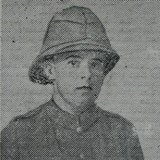
Thomas Rees Davies, Gunner, 164773, Royal Field Artillery. Thomas was born in Llangorwen. He enlisted in Aberystwyth into the Royal Artillery, and was posted to France with “A” Battery, 165th Brigade, Royal Field Artillery, which was attached to the 31st Division. In March 1916 the division moved to France, and saw its first major action at the Battle of Albert in July 1916, suffering heavy casualties at Serre. It was withdrawn for several months as a result. They moved back into the line in November 1916 and took part in the Battle of the Ancre, and then wintered on the Ancre, until moving to Arras the following year. Here it fought at the Third Battle of the Scarpe, and helped in the capture of Oppy Wood. At the beginning of 1918 the Division was in the St. Quentin sector. It was here that it was among the Divisions hit by the German Spring Offensive of 21 March 1918 at the Battle of St Quentin. The division suffered terribly again, and was moved to Flanders to rest, but was caught up in heavy fighting there when the Germans switched the focus of their offensive to the Lys Valley the following month. Thomas was killed in action on 21 April 1918, and is buried in St Amand British Cemetery, France. He is commemorated on a memorial at Capel Noddfa, Bow Street.
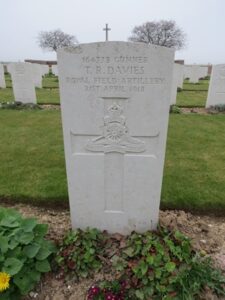
Alfred Thomas Edwards, Private, 27022, Royal Welsh Fusiliers. Alfred was the son of John and Mary Edwards, of 10, Little Darkgate Street, Aberystwyth. He enlisted at Holborn, London into the Royal Welsh Fusiliers, and was posted to France early in 1916, joining the 1st Battalion, Royal Welsh Fusiliers, which was attached to 22 Brigade, 7th Division. The battalion was on the Somme, stationed near Fricourt, where two of its officers included Robert Graves and Siegfried Sassoon, two of the most famous war poets. The battalion took part in the 1 July 1916 assault at Fricourt towards Mametz Village; one of the few successes of the opening day of the battle. After the 38th Division had captured Mametz Wood, the 7th Division moved past towards High Wood. Alfred was killed at High Wood on 3 August 1916. He was 24 years old, and is commemorated on the Thiepval Memorial, France.
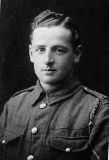
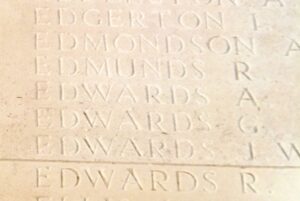
Ceredig Ellis, Second Lieutenant, Royal Welsh Fusiliers. Ceredig was the youngest son of David and Catherine Ellis, of Aberystwyth. Ceredig was a partner in a millinery and drapery business at Aberystwyth prior to the war, and had played football for Aberystwyth FC. He enlisted into the 15th Battalion, Royal Welsh Fusiliers, and whilst training at Colwyn Bay, met and married Mildred Cavanagh at Conwy in 1915, just prior to the battalions move to Winchester. The battalion was attached to 113 Brigade, 38th (Welsh) Division. On 4 December 1915 the battalion moved to France, and the entire Division moved to the Fleurbaix sector, where it was initiated into trench warfare. Ceredig had been commissioned as Second Lieutenant in the meantime, and joined the battalion at Cuinchy on 29 March 1916. During June 1916 the Division marched south to the Somme, and on 7 July 1916 attacked Mametz Wood. The initial attack failed, and it was three days later, on 10 July, that a fresh attack was mounted. Ceredig was wounded during the terrible fighting within the wood, and was evacuated to Abbeville, where he died of his wounds on 19 July 1916, aged 34. Ceredig is buried at Abbeville Communal Cemetery, France.
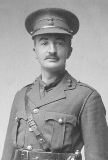
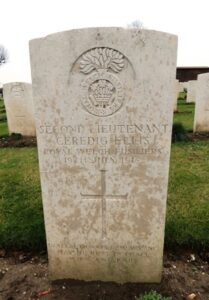
David Hubert Evans, Private, 50167, Welsh Regiment. Hubert was born at Llanidloes in 1888, the eldest son of Richard and Annie Evans. The family later resided at Madoc House, Queens Road, Aberystwyth. David enlisted at Cardiff into the Welsh Regiment, and served on the Western Front from early in 1917 with one of the Service Battalions of the regiment. Hubert was invalided home from France and after recovering was stationed at Redcar, Yorkshire, with the 3rd Battalion, Welsh Regiment. It was there that he contracted pneumonia and died on 16 January 1918 at Red Barnes Hospital, Redcar, his parents being present at his death. His remains were brought home to Aberystwyth by Sergeant Herbert, of the 3rd Welsh, before burial in Dolhafren Cemetery, Llanidloes, Mongomeryshire.
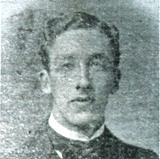
Edward David Evans, Company Sergeant Major, 14401, Kings Shropshire Light Infantry. Ted was born in 1887, the son of Edward and Elizabeth Evans, of 15, Baker Street, Aberystwyth. Prior to the outbreak of war he had worked at the L C & M Bank in Newcastle Emlyn. He enlisted at Carmarthen into the 7th Battalion, Kings Shropshire Light Infantry in September 1914 along with his close friend David Rees Davies. On 28 September 1915 the Battalion landed at Boulogne, joining 8 Brigade, 3rd Division at Meteren. The Division then moved to the Ploegsteert Wood sector, before moving to the Busseboom Sector at Ypres. The 7th KSLI took up positions in Sanctuary Wood, and fought at the Actions of the Bluff, and at the St Eloi Craters. The Division was then moved south to the Somme, and fought there at the Battle of Albert. During an assault on the German trenches at Bazentin Ridge on 14 July 1916, Ted’s company was caught on barbed wire and came under heavy fire from enemy machine guns. Ted was killed in action that day, and is commemorated on the Thiepval Memorial, France. He had severely felt the death of his old friend Sergeant David Rees Davies, of Aberystwyth, who had enlisted at the same time and had been killed a few weeks earlier.
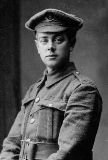
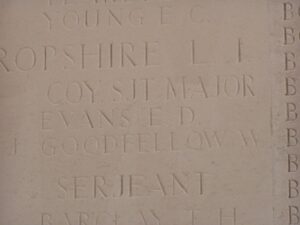
Edward Hugh Evans, Private, 66040, Cheshire Regiment. Edward was born in 1899, the son of Robert and Elizabeth Evans, of Nantcaerio, Llanbadarn Fawr. He had been educated at the County School, Aberystwyth, before taking up a post as the Assistant Librarian at the National Library of Wales. Edward enlisted at Aberystwyth into the 59th Training Reserve Battalion on 29 December 1916, and was posted to France on 18 January 1918, joining the 1/6th Battalion, Cheshire Regiment. The battalion was attached to 118 Brigade, 39th Division, which was stationed near St. Quentin. On 21 March 1918, the Division was hit by the German Spring Offensive, which swamped the British front line positions. The British were pushed back over the coming days, and Edward would have taken part in terrible fighting. He was killed in action on 26 March 1918, aged just 19, and is commemorated on the Pozières Memorial, France.
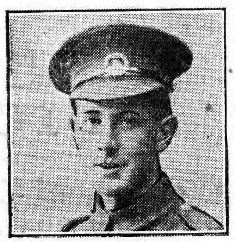
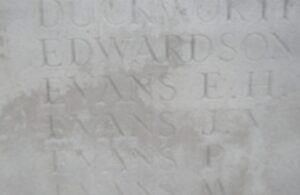
John Evans, Private, 21665, South Wales Borderers. John was born in Aberystwyth in 1880, the son of Evan and Margaret Evans. Prior to the war John worked as a miner, and lived with his wife Agnes at Cymmer, near Port Talbot. John enlisted at Aberavon into the 11th Battalion, South Wales Borderers. The battalion trained in North Wales as part of the newly formed Welsh Division, before moving to Winchester as part of 115 Brigade, 38th (Welsh) Division. The division moved to France on 2 December 1915, taking up positions in the Nursery Sector near Fleurbaix. John was an early casualty in his battalion, being killed on 7 February 1916 whilst the battalion was in reserve. He was 35 years old, and is buried in St. Vaast Post Military Cemetery, Richebourg-L’Avoue, France.
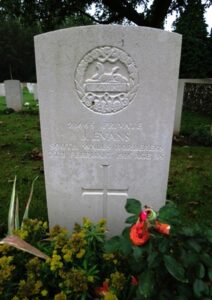
Thomas Edward Evans, Private, 160172, Canadian Infantry. Thomas was born on 5 August 1887, the son of James and Susannah Evans, of Goginan. He resided in Canada prior to the war and enlisted there into the 54th Battalion (Kootenay), Canadian Infantry, which was attached to the 11th Brigade, 4th Canadian Division. The Division embarked for France in August 1916, and moved to the Somme. The Division fought at the Battle of Le Transloy from 1 to 17 October, before taking part in the Battle of the Ancre Heights, when they captured Regina Trench. Thomas was killed in action here on 18 October 1916. He was 29 years old, and is buried at Adanac Military Cemetery, Miraumont, France.
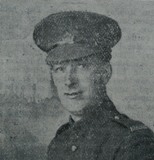
William Bailey Evans, Private, 39705, Welsh Regiment. William was born in 1896, the son of Captain William Evans of the Boar’s Head Hotel, Aberystwyth. He enlisted at Aberystwyth into the Welsh Regiment, and was posted to France late in 1916, joining the 15th Battalion, Welsh Regiment, which was known as the Carmarthen Pals battalion, attached to 114 Brigade, 38th (Welsh) Division. The Division had been in France since December 1915, and had taken part in the bloody capture of Mametz Wood in July 1916. The battered Welshmen had moved via Hebuterne to Boesinghe, on the Yser Canal, where it remained until launching its attack on Pilckem Ridge on 31 July 1917. After the successful capture of its objectives, the Division was withdrawn to rest, but the 15th Welsh remained in the line, in support of the Battle of Langemarck. William was killed in action here on 4 August 1917, aged 21, and is commemorated on the Ypres (Menin Gate) Memorial, Belgium.
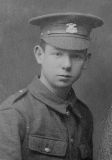
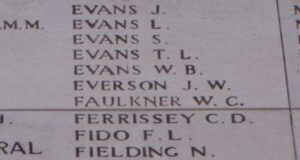
Cyril Mortimer Green, Captain, Royal Sussex Regiment. Cyril was the son of Thomas Mortimer Green and Catherine Green, of Aberystwyth, and the husband of Gwendoline Mortimer Green, of 23, Southwood Court, Golder’s Green, London. Cyril was a native of Denbigh, and had been educated at the University Colleges of Exeter, Carmarthen and Aberystwyth, along with his brother Hugh (see below), before being gazetted as Second Lieutenant into the 2nd Battalion, Royal Sussex Regiment in October 1914. Cyril was an eminent and brilliant plant ecologist at University College London. He undertook a detailed survey of Borth bog near Aberystwyth and pursued his interest in Palestine sending back details of plants in that part of the world. Cyril served in France until he was severely wounded at Festubert on 9 May 1915, and returned home for treatment. Returning to the front, he was attached to the 16th Battalion, Royal Sussex Regiment, who were attached to 230 Brigade, 74th Division. The Division was taking part in the advance into Palestine, and had just successfully fought in the Third Battle of Gaza, when Cyril was killed in action on 6 November 1917. He was 29 years old, and is buried at Beersheba War Cemetery, Israel.
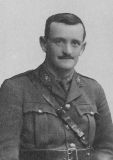
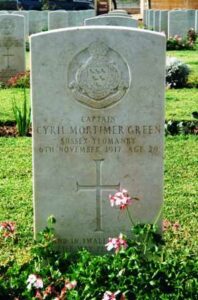
Hugh Mortimer Green, Captain, Welsh Regiment. Hugh was the son of Thomas Mortimer Green, former Registrar of Aberystwyth University, and Catherine Green, of Aberystwyth, and the Brother of Cyril Mortimer Green (see above). Hugh was educated at Carmarthen University along with Cyril, and was gazetted into the Welsh Regiment. He was posted to the 1/4th Battalion, Welsh Regiment, which was the local Territorial Battalion, attached to 159 Brigade, 53rd (Welsh) Division. The Division landed at Cape Helles, Gallipoli, on 9 August 1915, and was immediately thrown into action, spending the next few days in isolated pockets. Hugh was killed in action on 10 August 1915, aged 32, at the Battle of Sari Bair (Attack on Scimitar Hill). He has no known grave, and so is remembered on the Helles Memorial, Gallipoli.
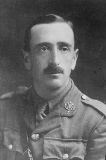
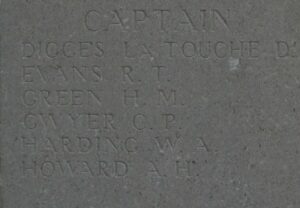
Oswald Robert John Green, Lieutenant, Welsh Regiment. Oswald was the son of William Arthur and Sophia Green of the Foundry, Aberystwyth, and the husband of Winifred Gwendoline Green, of Buchland House, Neath Abbey, Neath. George was educated at Jasper House and Aberystwyth University. He was a holder of the Royal Humane Society Medal for life saving from drowning, and always to the fore in local sport, excelling swimming, cricket, golf and especially football. He was a successful captain of Aberystwyth Town Football Club prior to the war and spurned many offers to turn professional. A prominent trait was if any of the younger players was severely tackled, he always made a point of “protecting them”, a train of thought he was to take with him onto the battlefield. Oswald returned from America at the end of 1914 to take up a commission in the 9th Battalion, Welsh Regiment, which was attached to 58 Brigade, 19th (Western) Division. The Division moved to France during July 1915, and moved to positions near Loos, where it took part in the opening attack of the Battle of Loos on 25 September 1915. The following year the Division moved to the Somme, where it took part in the second wave of the attack on Ovillers-La Boiselle on 1 July 1916, capturing the village at heavy cost. The 9th Welsh had played a big part in the taking of Ovillers, but Oswald had been mortally wounded. He died on 5 July 1916, aged 35, as a result of his wounds, and is buried at Heilly Station Cemetery, Mericourt-L’Abbe, France.
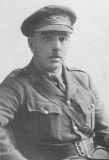
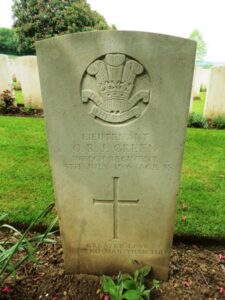
David Lewis Herbert, Engineer Mercantile, Marine. David was the son of Margaretta Herbert, of 27, Bridge Street, Aberystwyth. He was a long serving mariner, and by the outbreak of war was serving as Chief Engineer aboard the SS Reims, a transport steamer. David took ill whilst aboard Reims, whilst on voyage to Italy with a cargo of coal for the Italian Government. At the end of May 1917 his parents received a cable say he had been landed in Spain and taken to Aquilas Hospital where he later died on 17 May 1917. David is not commemorated by the Commonwealth War Graves Commission.
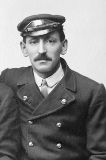
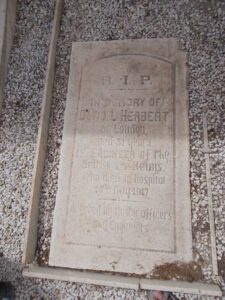
James John Herbert Howard, Lance Corporal, 19963, Royal Welsh Fusiliers. James was born in 1892, the son of Margaret Howard, of Mill Street, Aberystwyth. He was a faithful member of Tabernacle Chapel Sunday School and played football for Aberystwyth Town FC prior to the war. James originally enlisted at Aberystwyth into the 9th Welsh, but transferred to the 16th Battalion, Royal Welsh Fusiliers, which was attached to 113 Brigade, 38th (Welsh) Division. The Division had landed in France during December 1915 and had spent their first winter in the trenches near Armentieres. In June they marched south to the Somme, where they were tasked with the capture of Mametz Wood. The attack on the wood began on 7 July, but met with fierce resistance, and it took until 14 July to totally clear the wood. James suffered serious injuries to his leg and arm when a shell exploded near to him during the assault on Mametz Wood. Capt G D Ellis, his senior officer in the 16th RWF informed his parents that “there was little room to hope that he would recover”. James died on 12 July 1916, aged 23, and was buried in Carnoy Military Cemetery, France.
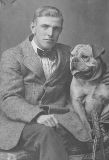
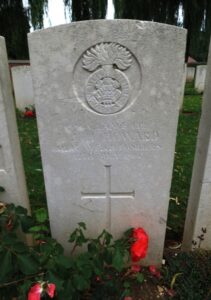
James James, Lance Corporal, 22127, Welsh Regiment. James was born in 1893, the son of Thomas and Sarah James of Llanbadarn. He enlisted at Tonypandy into the 15th Battalion, Welsh Regiment, which was known as the Carmarthen Pals battalion, attached to 114 Brigade, 38th (Welsh) Division. On 2 December 1915 the battalion moved to France, and the entire Division moved to the Fleurbaix sector, where it was initiated into trench warfare. During June 1916 the Division marched south to the Somme, and on 7 July 1916 attacked Mametz Wood. The initial attack failed, and it was three days later, on 10 July, that a fresh attack was mounted, and the 15th Welsh were thrown into the fray, in the Hammerhead section of the wood. James was killed in Mametz Wood on 11 July 1916. He was 23 years old, and is commemorated on the Thiepval Memorial, France. There is also a memorial to James at Capel Bethel, Cwmerfyn.
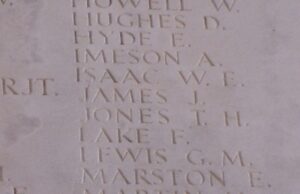
Thomas William James, First Engineer, Mercantile Marine. Thomas was the son of David and Mary Jane James (nee Rees), of 11, Sea View Place, Aberystwyth. He served with the Mercantile Marine as First Engineer on the SS Kildonan, a Cardiff registered steamer. On 26 October 1917, Kildonan was carrying a cargo of ore when she was torpedoed and sunk by the German submarine U-35. Thomas was 26 years old when he died that day, and is commemorated on the Tower Hill Memorial, London.
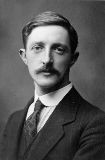
William James, Pioneer, 159319, Royal Engineers. William was the son of David and Mary James, of 17, Pencae, Taliesin. He originally enlisted at Aberystwyth into the South Wales Borderers, but was transferred to the 5th Battalion Special Brigade, Royal Engineers, which was a Special (Gas) Company. The Battalion was a Stokes mortar unit, attached to the Fourth Army. The Battalion was on the Somme in the summer of 1916, where it was to provide support for the forthcoming Battle of the Somme. William was killed during the build up to the battle, probably whilst moving equipment into place. He was 22 years old, and is buried at Hébuterne Military Cemetery, France.
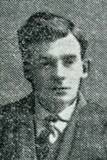
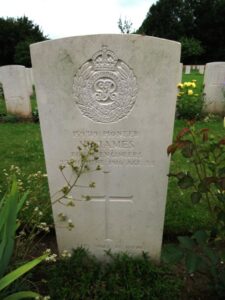
David Jones, First Engineer, Mercantile Marine. David, known locally as Dei, was the son of Captain Richard David Jones and Mary Jones, of Ael-y-Bryn, Talybont. He served with the Mercantile Marine as First Engineer aboard the SS Argyle, a Newport registered steamer. On 13 April 1917, Argyle was on route from Port Kelah for Middlesbrough with a cargo of iron ore, when she was torpedoed and sunk by the German submarine U-84, off Harwich, with the loss of 22 lives. David was 28 years old when he died that day, and is commemorated on the Tower Hill Memorial, London.
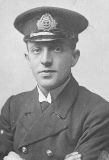
David John Jones, Able Seaman, J/21319, Royal Navy. David was the son of David Jones, of Holmhurst 5, Rheidol Terrace, Penparcau, Aberystwyth. David served with the Royal Navy aboard HMS Q27, a Q ship, which was an armed merchant ship, with concealed weaponry, designed to counter the U boat threat. David was 20 years of age when he drowned as his ship was sunk on 13 March 1917. He is commemorated on the Plymouth Naval Memorial, Devon.
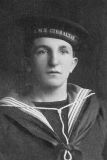
David Owen Jones, Gunner, 168380, Royal Field Artillery. David was born in London in 1887, the son of Daniel and Margaret Jones, of Hafodlasissaf. He enlisted at Aberystwyth into the Royal Field Artillery, and was posted to France at some time in 1916 with 23rd Battery, 40th Brigade, Royal Field Artillery, which was attached to the 3rd Division. David probably fought on the Somme on 1916, and moved to Ypres with the Division the following year. David was wounded at Ypres, and died of his wounds at Remi Sidings Casualty Clearing Station on 13 October 1917. He was 30 years old, and is buried at Lijssenthoek Military Cemetery, Belgium.
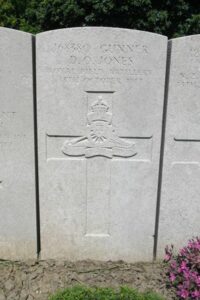
Edwin Griffiths Jones, Private, 22360, Royal Welsh Fusiliers. Edwin who was born at Aberystwyth and after graduating from the university in 1911 taught Geography at the County School enlisting from there into the 15th Battalion, Royal Welsh Fusiliers. The battalion was attached to 113 Brigade, 38th (Welsh) Division, and landed in France on 2 December 1915, moving to the Fleurbaix sector, where it was initiated into trench warfare. On 7 May 1916, a party of the 15th RWF was detailed to raid the German trenches at Fauqissart, and that night the men, armed with clubs, knives and rifles, crossed No Man’s Land into the German lines, killing around 50 Germans, and capturing several prisoners. Edwin was wounded during the raid, and was helped back to the Welshmen’s lines. He was evacuated to Hospital at Merville where he died on 8 May 1916. Edwin is buried at Merville Communal Cemetery, France.
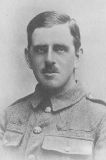
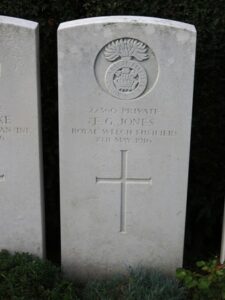
Emlyn Mason Jones, Gunner, 102654, Royal Garrison Artillery. Emlyn was the son of Edward and Laura Louisa Jones, of Gwynfa, Ponterwyd. Emlyn enlisted at Aberystwyth on 8 December 1915 into the Royal Artillery, and on 12 August 1916 was posted to the 236th Siege Battery, Royal Garrison Artillery, landing in France on 30 January 1917. The battery moved to positions near Ypres, where it supported the Allied assault on the Passchendaele Ridge from 31 July 1917 onwards. Emlyn was killed in action at Ypres on 22 December 1917. He was 21 years old, and is buried at Klein-Vierstraat British Cemetery, Belgium. His brother Iorwerth also fell. He was described as a man of unblemished character and his senior officer, Major Colman, wrote to his parents to say; “The loss to me is great, for he was one of those remaining who had shared all the discomforts of the twelve months we have spent overseas together.”
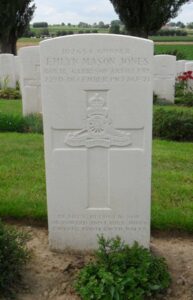
Frederic Robert Jones. Fred was born in Portland Street, Aberystwyth in 1885 and was the only son of Mr and Mrs Peter Jones JP. He was educated at Alexander Road School and Aberystwyth County School. On leaving school Fred served his engineering apprenticeship in Green’s Foundry, Aberystwyth before taking up employment at Metcalfe’s engineering works in Manchester and the Great Western railway works in Swindon. To progress his career he left for Canada in March 1912 and was employed in construction work on the Canadian Northern and Canadian Pacific Railways. Realising the urgent need for his engineering skills for the war effort he decided in 1915 to return home on the first available boat and offer his engineering skills to the armaments industry. Frederick booked second cabin passage on the RMS Lusitania from New York to Liverpool. The liner left New York on the 1 May and six days out, on the afternoon of 7 May 1915, the Lusitania was torpedoed by the German submarine U-20, twelve miles off the Old Head of Kinsale in southern Ireland, She sank within twenty minutes. No trace of his body was ever found. He was 30 years of age. Though not in the armed forces, Frederick Jones is commemorated on three war memorials in Aberystwyth; Aberystwyth County School, Alexander Road School and Bethel Chapel.
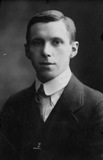
Hedley W. Jones, Rifleman, 2106, London Regiment. Hedley was raised at Aberystwyth, but prior to the outbreak of war resided at Campden Town, London. He enlisted at Chelsea into the 1/18th Battalion, London Regiment (London Irish Rifles). The battalion mobilised in August 1914 at the Duke of York’s Headquarters, Chelsea, as part of 5th London Brigade, 2nd London Division, and moved to the St Albans area. On 10 March 1915 the battalion landed at Le Havre, where its formation was renumbered as 141 Brigade, 47th (2nd London) Division. The Division fought at the Battle of Aubers, and the Battle of Festubert during May 1915 and in September fought at the Battle of Loos, and subsequent Action of Hohenzollern Redoubt. Hedley was killed near Loos on 24 December 1915. He has no known grave, and is commemorated on the Loos Memorial, France.
Iorwerth Mason Jones, Ordinary Seaman, J/85359, Royal Navy. Iorwerth was born on 5 July 1888, the son of Edward and Laura Louisa Jones, and was the husband of Mary Jones, of Pengraig, Capel Bangor. He entered the Royal Navy in March 1918 having been in the employ of his father throughout the war, as the postmaster at Penllwyn Post Office. Iorwerth was posted to HMS Vivid, the Royal Naval establishment at Portsmouth. Iorwerth died from disease at East Stonehouse, Devon on 20 March 1918, aged 29, and is buried at Penllwyn Calvinistic Methodist Chapelyard.
John Arllwyd Jones, BA, Second Lieutenant, Welsh Regiment. John was born in 1883, the son of David and Elizabeth Jones, of Gyfaellwyd View, Devils Bridge. Prior to the war he became a Teacher at Wrexham County School, and resided with his wife, Winifred Jones, at 56, Alexandra Street, Wrexham. John enlisted at Wrexham into a Training Battalion of the Royal Welsh Fusiliers. He was commissioned into the Welsh Regiment, and landed in France on 6 June 1917, joining the 9th Battalion, Welsh Regiment, which was attached to 58 Brigade, 19th (Western) Division. He joined the battalion at Messines, and fought with them during the latter stages of the Battle of Messines, and at the opening of the Battle of Pilckem Ridge on 31 July 1917. The Division was relieved on the night of 7/8 August, and after a brief rest, moved back into the front line on 11/12 September, taking up positions near Klein Zillebeke. Here the Division geared up in readiness for a planned attack on 20 September, the Battle of the Menin Road. John was killed in action during the opening of the battle, early on 20 September 1917. He was 34 years old, and is commemorated on the Tyne Cot Memorial, Belgium.
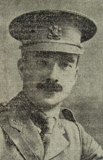
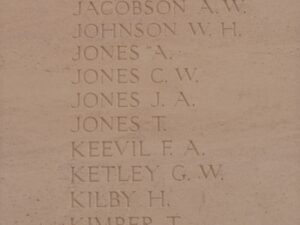
Thomas David Jones, Rifleman, R/4270, King’s Royal Rifle Corps. Thomas was born at Miles Platting, Lancashire in 1883, the son of Mary Jones. He was brought up in Aberystwyth, and had served for six months with the 1st Cardigan Volunteer Artillery in 1902. Thomas enlisted on 13 September 1914 at St. Paul’s Churchyard, London, into the King’s Royal Rifle Corps. On 8 October 1914 Thomas was posted to the 13th Battalion, King’s Royal Rifle Corps. The battalion moved to Windmill Hill, Salisbury Plain in April 1915, joining 111 Brigade, 37th Division, before landing at Boulogne on 31 July 1915. The division concentrated near Tilques, before moving into positions on the Somme, where it saw its first major action on 1 July 1916 at the Battle of Albert. On 4 August 1916, Thomas was admitted to the 2nd Field Ambulance, suffering from multiple gunshot wounds, which he’d suffered during an attack on the Somme that day. Thomas died of his wounds on 8 August 1916, aged 32. He is buried in Bois Guillame Communal Cemetery, France.
John Emrys Lewis, Second Lieutenant, Somerset Light Infantry. John was born in 1891, the son of Jenkin and Mary Anne Lewis, of Rhiwmynach, Devils Bridge. He was a Teacher prior to the war, and was commissioned into the Somerset Light Infantry. John landed in France on 20 May 1916, and proceeded to join the 8th Battalion, Somerset Light Infantry, which was attached to 63 Brigade, 21st Division. John joined the battalion on the Somme, where it was preparing for its part in the forthcoming offensive of 1 July 1916. The 21st Division moved into positions near Fricourt, with the 8th Somerset Light Infantry being allotted a section of the line opposite Empress Trench, north of Fricourt. At 06.30 on 1 July 1916, amidst the noise of huge underground mines being blown beneath the German lines, whistles blew, and the British climbed out of their trenches. The Somerset’s took their objectives, but had suffered heavily whilst doing so, coming under intense German machine-gun fire. John had been killed in the early charge that morning. He was 24 years old, and is today buried at Gordon Dump Cemetery, Ovillers-La Boiselle, France. His brother, David, had been killed at Cuinchy on 18 February 1916.
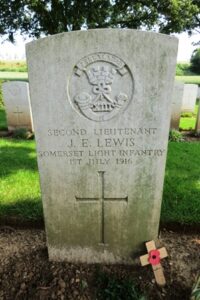
Trefor Lewis, Private, 77027, Royal Army Medical Corps. Trefor was the son of James and Elizabeth Lewis of Willows, 27, Portland Street, Aberystwyth. He was employed on the clerical staff of the National Library of Wales and a member of St Paul’s Chapel, prior to enlisting into the Royal Army Medical Corps. Trefor was posted to the 5th Field Ambulance, Royal Army Medical Corps, which was attached to the 2nd Division. The Division had been in France since the outbreak of war, and had fought in the retreat from Mons to the Marne. The 2nd Division was then moved to Flanders, and fought at the First Battle of Ypres, when the German sweep through Flanders was stopped, remaining there throughout the first winter of the war. In 1915 they took part in the Battle of Festubert, and in September fought at the Battle of Loos, and subsequent Action of Hohenzollern Redoubt. In the summer of 1916 the Division was on the Somme, and took part in the Battle of Delville Wood. Trefor was wounded here on the 8 August 1916. He was repatriated back to the UK and admitted into Hampstead Hospital where he died on 20 August 1916, aged 20. Trefor was buried with full military honours in Aberystwyth Cemetery.
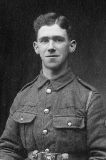
David Albert Lloyd, Third Engineer, Mercantile Marine. David, known as Albert, was born in Aberaeron and was the son of David and Mary Lloyd. The family later resided at 36, Queen Street, Aberystwyth. David was a long serving seaman. On 1 May 1915 he survived when his ship, the SS Edale, was torpedoed by the German submarine U-30, whilst on voyage from Argentina to Liverpool. Upon returning to Britain, he was posted aboard the SS Blake, a London registered steamer. On 24 July 1917, Blake was torpedoed and sunk by the German submarine UC-49, whilst on route from Penarth to Archangel, with the loss of five lives. David was 29 years old when he died that day, and is commemorated on the Tower Hill Memorial, London. John Richards of 30, South Road was Second Engineer on the same ship and survived. He said she sank inside two minutes and of the 56 on board, 51 were saved but Albert was missing.
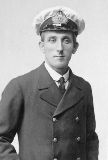
Hugh Lloyd, Lieutenant, King’s African Rifles. Hugh was born in 1890, the son of Edward and Sarah Lloyd, of Parcyllyn, Llanbadarn. He worked in London as a Bank Clerk prior to the war, before enlisting into the Motor Machine Gun Corps. Hugh landed in East Africa on 16 March 1916, probably serving in an armoured car unit, operating against the German forces in East Africa. He was commissioned into the 1st/3rd Battalion, King’s African Rifles on 27 April 1917. Sadly Hugh took ill, and died in Africa on 19 July 1917. He was 27 years old, and is buried at Dar Es Salaam War Cemetery, Tanzania.
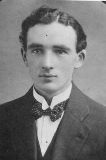
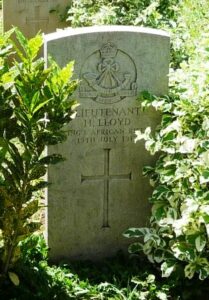
Desmond Maurice Macartney-Filgate, Second Lieutenant, Royal Air Force. Desmond was the son of Charles and Mary Macartney-Filgate, of Florence Place, Borth, and grandson of the late Townley Macartney-Filgate, of Lowtherstone, Balbriggan. He was commissioned into the Royal Flying Corps on 9 March 1918, and attached to the 42nd Training Squadron, Royal Flying Corps, where he trained as a pilot. Desmond was seriously injured in a training accident in May 1918, and died on 31 May 1918, aged just 18. He is buried at Wye (Ss. Mary and Martin) Churchyard, England.
John Ivor Morgan, Gunner, 731220, Royal Field Artillery. John was born in 1896, the son of John Bunce Morgan and Jane Morgan, of Glanfred, Llandre, Aberystwyth. He enlisted at Bedford into the Royal Artillery, and was posted to A Battery, 37th Brigade, Royal Field Artillery. The battery formed in Egypt in September 1917, attached to the 75th Division. The Division served in Egypt and Palestine, taking part in the Third Battle of Gaza. They then fought at the Capture of Junction Station, the Battle of Nabi Samweil, the Battle of Tell’Asur, the Battle of Berukin, and the Battles of Megiddo. They remained in Palestine for the duration of the war. John was killed in action in Palestine on 19 September 1918. He is buried in Ramleh War Cemetery, Egypt.
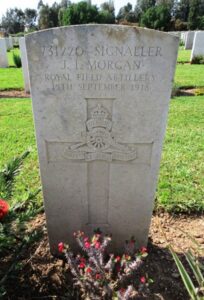
John Frederick Parry, Lance Corporal, 32518, Welsh Regiment. John was born in Capel Bangor, the son of David Griffith Parry and Elizabeth Parry, of Neuadd Villa, Taliesin, Glandyfi, Cardiganshire. Prior to the war the family had moved to Brynawel Hotel, Aberystwyth. John enlisted there into the 15th Battalion, Welsh Regiment, which was known as the Carmarthen Pals battalion, attached to 114 Brigade, 38th (Welsh) Division. On 2 December 1915 the battalion moved to France, and the entire Division moved to the Fleurbaix sector, where it was initiated into trench warfare. During June 1916 the Division marched south to the Somme, and on 7 July 1916 attacked Mametz Wood. The initial attack failed, and it was three days later, on 10 July, that a fresh attack was mounted. After two days of heavy hand to hand fighting within the wood, the Germans withdrew, and the battered Welshmen moved via Hebuterne to Boesinghe, on the Yser Canal, where it remained until launching its attack on Pilckem Ridge on 31 July 1917. The 15th Welsh remained in the line, and also took part in the Battle of Langemarck, before the entire Division was moved to positions near Armentieres over the winter. After the Germans launched their offensive on the Somme on 21 March 1918, the Division was moved back to the Somme, and took up positions north of Albert, around Aveluy Wood. On 10 May 1918, the 15th Welsh attacked the German positions in Aveluy Wood, supported by an artillery barrage. The artillery officer had miscalculated the range, and their fire was brought down on the 15th Welsh, who suffered heavy casualties. John was badly wounded in Aveluy Wood, suffering a gunshot wound to his right leg and a fractured fibula, and died at Doullens that same day. He was 28 years old, and is buried in Doullens Communal Cemetery Extension, France.
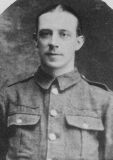
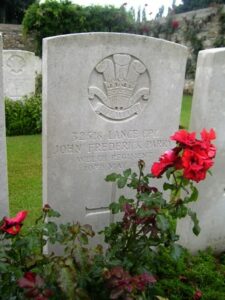
James Rowlands, Private, 4660, Australian Infantry. James was born in 1885, the son of William and Margaret Rowlands, of 9, North Parade, Aberystwyth. He emigrated to Australia in 1912 and took up employment as a bank clerk in Melbourne. On 21 August 1915 James enlisted at Melbourne into the 7th Infantry Battalion, Australian Imperial Force, and embarked from Melbourne on 28 February 1916, aboard HMAT Themistocles. He disembarked at Suez on 28 February 1916, and joined up with his battalion in Egypt, where it was rebuilding after the Gallipoli campaign, and was attached to the 2nd Brigade, 1st Australian Division. In March 1916, the Division sailed for France, and entered the front line trenches in Flanders on 3 May 1916. The Divisions first major action in France was at Pozières, during the Somme offensive, where it fought between 23 to 27 July and at Mouquet Farm from 15 to 21 August. The battered Division was moved to Ypres, but returned to the Somme, spending the winter on 1916/1917 in trenches near Flers. In early 1917, the Germans withdrew to the Hindenburg Line and the 7th Battalion took part in the advance that followed, and stopped near Bullecourt. The battalion was withdrawn from the front line for training on 9 May 1917 and did not return to action until the Ypres offensive of September and October. It fought major battles at the Menin Road on 20 September and Broodseinde on 4 October 1917. James was killed by a shell at Broodseinde on 4 October 1917. He was 32 years old, and was buried on the battlefield. His grave was later relocated, and today, James is buried in Tyne Cot Cemetery, Belgium. James had a colourful army career. He had been court martialled several times for being absent without leave, and had been reduced from Corporal to Private after suffering a spell in prison.
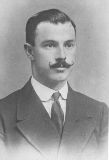
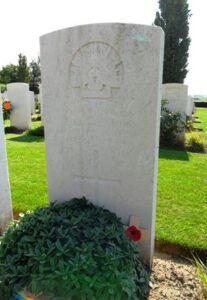
Harold Sylvanus Thomas, Private, 9909, Honourable Artillery Company. Harold was born at Aberystwyth, the son of John and Margaret Thomas, of Granville, 1, North Parade. He resided in St. Clears at the outbreak of war, where he worked as a Bank Clerk, and enlisted at Carmarthen on 8 December 1915, and the following month was at Armoury House, London, after being posted to the 2nd Battalion, Honourable Artillery Company. The Battalion was attached to 22 Brigade, 7th Division, and on 3 October 1916 landed at Havre, taking part in the advance to the Hindenburg Line in early 1917 after the German withdrawal. In Spring 1917 the Battle of Arras was launched, and Harold was killed in action on 15 May 1917, during the Battle of Bullecourt, after being shot in the head. He was 25 years old, and is commemorated on the Arras Memorial, France.
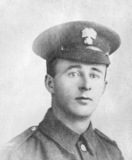
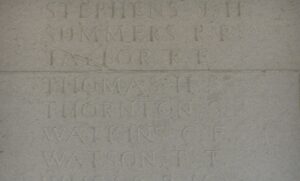
Spencer Morris Treharne, Corporal, 9794, Honourable Artillery Company. Spencer was the son of Gomer Treharne, and of Matilda Treharne (nee Llewellyn), of Lenton House, Victoria Terrace, Aberystwyth. He enlisted at Mill Hill, Middlesex on 30 December 1916 into the Honourable Artillery Company, and was posted to France on 20 March 1917, joining the 2nd Battalion, Honourable Artillery Company, which was attached to 22 Brigade 7th Division. In March 1917 the division followed the German Retreat to the Hindenburg Line, and took part in Flanking Operations Round Bullecourt. Later in the year the Division moved to Ypres, and fought at the Battle of the Polygon Wood. Spencer was killed in action during the advance to the east of the wood, on 9 October 1917. He was 29 years old, and is commemorated on the Tyne Cot Memorial, Belgium.
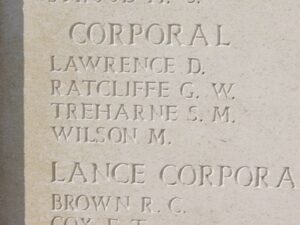
George James Vearey, Private, 29610, South Wales Borderers. George was born in 1884, the son of James and Mary Vearey, of 17, Northgate Street, Aberystwyth. He married Margaret Ann Rees, of Half-Way Inn, Trerddol, Glandyfi at Aberystwyth in the summer of 1917, just before embarking for France, joining the 1st Battalion, South Wales Borderers. The battalion was on the Flanders Coast attached to 3 Brigade, 1st Division, and was preparing for an assault along the coast. After the Third Battle of Ypres had ground to a halt in the mud, the coastal operation was called off, and the 1st Division moved to Ypres. George was killed in action here during the Second Battle of Passchendaele, on 10 November 1917. He was 33 years old, and is commemorated on the Tyne Cot Memorial, Belgium.
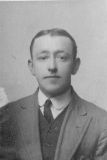
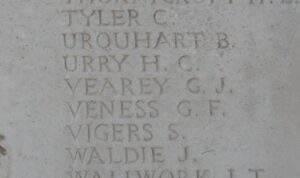
John Parry Williams, Third Engineer, Mercantile Marine. John was born at Llanrhystud in 1894, the son of John Thomas and Jane Williams (nee Parry). The family later resided at the Post Office, New Cross, Aberystwyth. John was an iron worker prior to the war, before becoming an engineer with the Mercantile Marine, serving aboard the SS Argyll, a Newport registered Turret Hull steamship. On 13 April 1917, Argyll was on route from Port Kelah for Middlesbrough with a cargo of iron ore, when she was torpedoed and sunk by the German submarine U-84. John was among 22 men killed in her sinking. He was 23 years old, and is commemorated on the Tower Hill Memorial, London.
Albert Edward Young, Private, 1658, Welsh Guards. Albert was born in Llannon in 1895, the son of James and Anne Young, of Aberystwyth. Albert resided in the Police Station, Llandyssul prior to the war, where his father was a Police Constable. He enlisted at Carmarthen into the 1st Battalion, Welsh Guards, which had been formed by Royal Warrant of 26 February 1915. They landed at Havre on 8 August 1915, where they were attached to 3 Guards Brigade, Guards Division. They saw their first action at the Battle of Loos the following month, and suffered terrible casualties before moving north to Ypres, where they were to remain until moving south to the Somme in July 1916 to take part in the Somme Offensive. Albert was wounded just before the Guards Division made their move to the Somme, on 1 July 1916. He was brought to the Base Hospital at Wimereux where he died of wounds on 10 July 1917. He was 21 years old, and is buried in Wimereux Communal Cemetery, France.
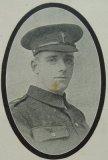
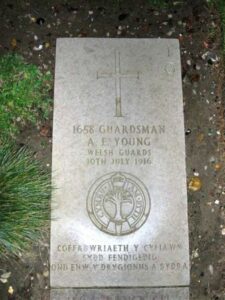
Ardwyn Grammar School Aberystwyth, World War Two, 1939-1945
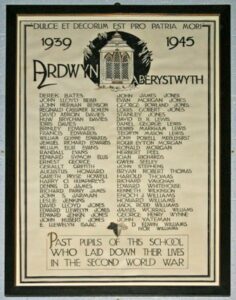
Derek Jones Bates, Flight Sergeant, 1684954, Royal Air Force Volunteer Reserve. Derek was the son of Henry Walter Bates and Lilian Scandrett Bates (nee Jones), of Hale Cheshire. His mother was from Aberystwyth, and her brother, Robert Brython Jones, had been killed in 1918, during WW1. Derek’s father, a WW1 veteran, died in 1927, so Lilian moved back to Aberystwyth and Derek was educated at Ardwyn School. He enlisted into the Royal Air Force Volunteer Reserve at the outbreak of war and served with 114 Squadron, Royal Air Force Volunteer Reserve, which was based in the Mediterranean area from 1942 through to 1945, equipped with the Douglas Boston. The squadron took part in the invasion of North Africa and had moved to mainland Italy. On 21 February 1945 Derek was from a night intruder mission in the Treviso area aboard a Doglas Boston, Serial BZ460, when it crashed into the sea off Falconara, with the loss of all of her crew of four. Derek was 23 years old when he died that day and is commemorated on the Malta Memorial, Malta.
John Lloyd Bebb, Captain, Air Transport Auxiliary. John was born on 4 July 1901, the son of William Bruce Bebb and Elizabeth Bebb of Capel Bangor, and the husband of Laura Jane Bebb, of Aberystwyth. He obtained his pilot’s license in 1932, and owned his own aircraft, an Avro 640 Cadet. John served with the Air Transport Auxiliary, a civilian organisation that ferried new, repaired and damaged military aircraft between factories, assembly plants, and transatlantic delivery points. John was flying a Curtiss Mohawk AR671 when it stalled whilst attempting a forced landing at Pershore Aerodrome following engine failure and crashed into the ground, killing him. He was 40 years old and is buried in Capel Madog Methodist Chapelyard.
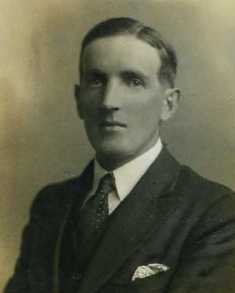
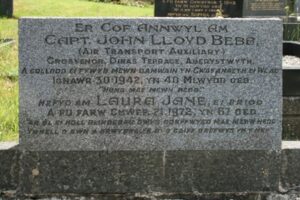
Herman Benson, Leading Writer, D/MX 67836, Royal Navy. Herman was the son of Russell Heber Benson and Elizabeth Benson, of Aberystwyth. He served on the Cruiser HMS Charybdis, which had been commissioned in December 1941. In 1942 she did valuable service in the Mediterranean, as an escort ship during the important Malta Convoys. In October 1943 she was part of a force sent to intercept the German blockade runner Munsterlund off the Britanny coast, but during the night a flotilla of German torpedo boats attacked the Charybdis and the other vessels and made off into the night. The Charybdis was sunk with the loss of 30 officers and 432 ratings. Herman was 23 years of age when he lost his life on 23 October 1943 and is commemorated on the Plymouth Naval Memorial, Devon.
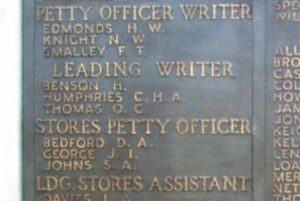
Reginald Cassimer Bohlen, Major, 173082, Royal Berkshire Regiment. Reg was the son of Cassimer John Read Bohlen, and Lucy Eva Bohlen, of Wallingford, Berkshire. Reg was a major with the 10th Battalion Royal Berkshire Regiment which was part of the allies landing force at Anzio in January 1944. The allies suffered heavy losses but the beachhead was secured. Despite a staunch resistance by the Germans, the battle line moved slowly forward, and Reg was killed in action on 28 February 1944. He was 26 years old and is commemorated on the Cassino Memorial, Italy.
David Aeron Davies, Able Seaman, P/JX 224550, Royal Navy. David was born at Tonypandy on 22 September 1917, the son of Ivor and Elizabeth Davies. The family later resided at Aberystwyth. David served on the destroyer HMS Beverley which saw service in the North Atlantic. Whilst providing escort for convoy ON 176 southwest of Iceland she sustained serious damage in a collision with SS Cairnvalona causing her to drop to the rear of the convoy. Two days later, on 11 April 1943 and with her anti-submarine gear damaged she was hit by a torpedo during a night attack by U-188, and sank with the loss of 151 lives. David was 25 years old when he died that day, and is commemorated on the Portsmouth Naval Memorial, Hampshire.
Hugh Brychan Davies, Captain, 232195, 1st Battalion The Buffs, (Royal East Kent Regiment). Hugh was the son of William Protheroe Davies and Hannah Mary Davies, of Brixton, London. He was a corporal in the London Scottish Regiment, serving in the Middle East, when he was commissioned into the 1st Battalion, East Kent Regiment, (The Buffs). High was leading his company during an attack in Italy when he was killed on 12 April 1944, aged 28. He is commemorated on the Cassino Memorial, Italy.
Idris Davies, Private, 5387186, South Staffordshire Regiment. Idris was the son of the Reverend David Stephen Davies and Emily Davies, of Streatham Hill, London, late of Tynant, Talybont. He served with the 1st Battalion, South Staffordshire Regiment in North Africa. Idris was wounded in Egypt, and died of his wounds on 13 January 1942, aged 23. Idris is buried in Alexandria (Hydra) War Memorial Cemetery, Egypt.
Francis Joseph Edwards, Sergeant, Wireless Operator/Air Gunner, 1316995, Royal Air Force Volunteer Reserve. He was the son of Joseph and Elizabeth Edwards of Aberystwyth and served with 427 (Royal Canadian Air Force) Squadron. Formed in 1942 the squadron was originally equipped with Wellington aircraft before being re-equipped with Halifax aircraft at the time of Francis’ death. On 18 April 1944 the squadron, made up of fifteen aircraft, was detailed to target Le Bourget in France. The mission was considered a success with all aircraft returning safely except Halifax BIII, LV789. The aircraft, piloted by Warrant Officer G H Coathup, was lost with Francis and all the crew of seven killed. He was 23 years of age and is buried with his fellow crew members in Clichy Northern Cemetery, France.
Jemuel Richard Edwards, Flight Sergeant, 1286856, Royal Air Force Volunteer Reserve. Jemuel was the son of Owen and Ellen Ann Edwards, of Aberystwyth. He served with 296 Squadron, Royal Air Force. The Squadron was formed on 25 January 1942, at RAF Ringway from the Glider Exercise Unit, and moved to Netheravon to tow Hotspur Gliders on training flights. In May 1942 it began to receive Armstrong Whitworth Whitleys. On 8 September 1942, Jemuel was aboard Whitley Serial BD436 of 296 Squadron, and whilst climbing out of the front hatch of the aircraft walked into the airscrew, which was still turning. Jemuel was 24 years old, and was brought home for burial at Aberystwyth Cemetery.
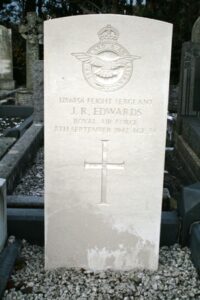
Thomas Brinley Edwards, Lance Sergeant, 984699, Royal Horse Artillery. Brinley was born on 4 February 1914, the son of Hugh Jenkin Edwards, and of Anne Marie Edwards (nee Jones), of Aberystwyth, and had played football for Aberystwyth FC prior to the war. He served with 11 (Honourable Artillery Company) Regiment, Royal Artillery, which served in North Africa, equipped with Priest self-propelled guns. Brinley was taken prisoner after the fall of Tobruk, and was handed over to the Italians. He was among a number of POWs taken aboard the S.S. Scillin, which sailed from Tripoli for Italy on 14 November 1942. During the night the ship was torpedoed and sunk by the Royal Navy Submarine HMS Sahib, and 783 POWs drowned. Thomas was 28 years old when he died that night, and is commemorated on the Alamein Memorial, Egypt.
William Glynne Edwards, Lieutenant, Royal Navy. William was the son of William and Mary Lloyd Edwards, of Aberystwyth. He served with the Royal Navy aboard the destroyer HMS Harvester. In March 1943 whilst she was providing escort duties for convoy HX 228 in the Atlantic she forced U-444 to the surface before ramming her. Shortly after on 11 March 1943 she was herself torpedoed by U-432, breaking in half and sinking with the loss of 9 officers and 136 ratings. William was amongst those lost. He was 31 years old and is commemorated on the Chatham Naval Memorial, Kent.
Edward Symond Ellis, Lieutenant, Royal Naval Reserve. Edward was the son of David and Mary Rachel Ellis, of 28, Little Dark Street, Aberystwyth. He married Dorothy Phillips, of Holywell, Flintshire, in 1935. Edward served with the Royal Navy aboard HMS Bonaventure, a light Anti Aircraft Cruiser. On 31 March 1941 she was on escort duty with convoy GA-008, from Greece to Alexandria when she was torpedoed and sunk approximately 100 miles south southeast of Crete by the Italian submarine Ambra. Edward was 32 years old when he died that day, and is commemorated on the Plymouth Naval Memorial, Devon.
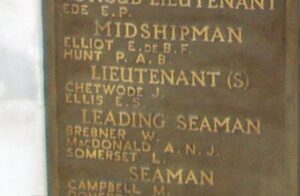
Thomas Randall Evans, Sergeant, 1299215, Royal Air Force Volunteer Reserve. Thomas was the son of Thomas Edward and Margaret Julia Evans, of Goginan. He served with 625 Squadron, Royal Air Force, which was a heavy bomber squadron, equipped with the Avro Lancaster. On the night of 19/20 February 1944, Thomas took off from Kelstern in Lincolnshire aboard Lancaster CF-X, Serial LM384, bound for Leipzig, which had been targeted as a crucial fuel producing target. The aircraft crashed outside the village of Bledeln in Germany early on 20 February 1944, killing all bar one of her crew. Thomas was killed in the crash on 20 February 1944. He was 22 years old, and is commemorated on the Runnymede Memorial, Surrey.
William Eilir Evans, Corporal, 6471528, 2nd Royal Fusiliers, (City of London Regiment). William was the son of William and Jane Evans, of Llangwyryfon, Ceredigion. William served in the 2nd Battalion Royal Fusiliers (City of London Regiment). In January 1943 the battalion had recovered from its mauling at Dunkirk having reformed and taken on new drafts. William found himself with the reformed battalion in North Africa where they joined the 8th Army to help deliver the final blow to Rommel’s Africa Corps. William met his death on 29 April 1943, in the preparation for the final drive to Tunis and victory. He was 26 years old, and is buried in Massicault War Cemetery, Tunisia.
John Roger Eyton-Morgan, Flying Officer, 162004, Royal Air Force Volunteer Reserve. John was the son of Thomas and Nellie White Eyton-Morgan, of Fronhyfryd, Llanbadarn Road, Aberystwyth. John volunteered to serve with the Royal Air Force, and was sent to South Africa, where he trained as a pilot. Upon his return to Britain, he was posted as a Pilot with 144 Squadron, Royal Air Force, which was a Coastal Command Squadron, equipped with the Bristol Beaufighter. At 14.30 on 26 April 1945, a force of 28 Beaufighters from Dallachy Strike Wing took off to attack shipping in Fedafjord, escorted by twelve Mustangs of 19 Squadron. When the force crossed the Norwegian coast, they were hit by flak and German fighters. John’s aircraft, Beaufighter PL-E, was hit by machine-gun fire, which caused it to crash into a hill, killing John and his Co-Pilot, Flight Sergeant James Thomson Knox. They are both buried at Feda Churchyard, Norway. John was just 21 years old.
Daniel Ernest George, Pilot Officer, 121564, Royal Air Force Volunteer Reserve. Daniel, known as Ernest, was born in 1910, the son of Daniel Henry George and of Agnes Lilly George, of 7, Skinner Street, Aberystwyth. He was residing at 5, Salisbury Road, Wrexham at the outbreak of war, with his wife, Joan George, before enlisting into the Royal Air Force, and becoming a Pilot. Daniel then served with 540 Squadron, Royal Air Force, which was a photo-reconnaissance unit, equipped with the Supermarine Spitfire IV and the De Havilland Mosquito. Daniel was posted as missing presumed killed when he failed to return after an operation on 3 April 1943. His aircraft, a Mosquito PR.IV, Serial DZ487 was never found. Daniel was 32 years old, and is commemorated on the Runnymede Memorial, Surrey. His navigator, John Drysdale Mair, was also lost.
Gerallt Tegwyn Griffith, Flying Officer, 80889, Royal Air Force Volunteer Reserve. Gerallt was born in 1896, the son of William Gwyn and Annie Griffith. Prior to the war he lived with his wife, Gwyneth Elizabeth Griffith, at The Bay Hotel, Aberystwyth. He was commissioned as a Flying Officer on 20 October 1923, and served with the Royal Air Force for several years prior to the outbreak of war. On 14 June 1940, Gerallt rejoined the Royal Air Force Volunteer Reserve, after being re-commissioned as a Flying Officer. After the invasion of Europe on 6 June 1944, Gerallt joined the invasion forces as part of the RAF Regiment, and took part in the liberation of Holland. On 17 December 1944, he was enjoying a night off, and was watching a film at the Rex Cinema in Antwerp when the building was hit by a German V2 rocket, which killed almost 600 people. Gerallt was 48 years old, and is buried in Schoonselhof Cemetery near Antwerpen, Holland.
Augustus Howard, Flight Serjeant/Pilot, 1600185, Royal Air Force Volunteer Reserve. Augustus was the son of Harry and Eleanor Howard of Marlow, Buckinghamshire. Eleanor was from Aberystwyth, and Augustus was educated at the Grammar School, before joining the Royal Air Force, and training as a Pilot. On 4 March 1945, Augustus was flying on a training flight aboard Lancaster III, Serial III ND387, when it was shot down by a German fighter, crashing near Ketton, Rutland with the loss of all six of her crew. Augustus was 21 years old when he was killed that day and is buried in Marlow Cemetery.
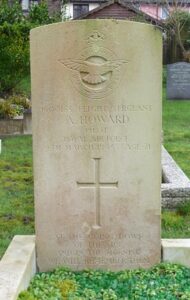
Gareth Pryse-Howell, Sergeant, 1282866, Royal Air Force Volunteer Reserve. Gareth was the son of John Pryse Howell and Phyllis Pryse Howell, of Aberystwyth. He enlisted into the Royal Air Force Volunteer Reserve and was posted to 1 TTU. Gareth was killed on 12 October 1942, whilst flying aboard a Handley Page Hampden I, Serial AN151 of Coastal Command, which crashed with the loss of all four of her crew. Gareth was 22 years old, and is commemorated on the Runnymede Memorial, Surrey. One other crew member is commemorated on the Runnymede Memorial, whilst the remains of the other two men were recovered.
Owen Henry Humphreys, Captain, 244160, General List. Owen was known as Harry, and was the son of Owen and Caroline Humphreys, of Aberystwyth. He was commissioned from the Royal Army Service Corps on 26 August 1942, joining the General List of officers. Harry took part in the Normandy invasion, and the ensuing liberation of Belgium and Holland in 1944. He was killed near Brussels on 7 December 1944, aged 33, and is buried in Brussels Town Cemetery, Belgium. Within a month of his death, Harry was Mentioned in Despatches for his services in Northwest Europe.
Edward Llewelyn Isaac, Civilian. Edward, known as Llewelyn, was the son of Arthur Llewelyn Isaac and Annie Isaac, of 32, North Parade, Aberystwyth. On 17 April 1941 Llewelyn was at home at 32, Oakley Square, Mornington Crescent, St Pancras, when the area was bombed, during the London blitz. Llewelyn was 32 years old. His body was not found until the area was finally cleared on 21 May 1941. He is commemorated in the Civilian War Dead Roll of Honour, located near St. George’s Chapel in Westminster Abbey, London.
David Dennis James, Telegraphist, D/JX 211773, Royal Navy. David was born in Llandovery on 13 December 1919. His family must have moved to Aberystwyth as David was educated at Ardwyn School. He enlisted into the Royal Navy and was posted aboard the frigate HMS Mourne. On 15 June 1944, Mourne was in action, supporting the Normandy Landings, when she was torpedoed and sunk by the German submarine U-767 in the English Channel. Three days later, whilst still in the channel, the U-Boat was to suffer a similar fate when she was hunted down by British destroyers with depth charges, and sunk. David is commemorated on the Plymouth Naval Memorial, Devon.
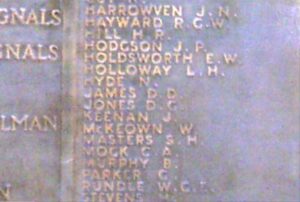
Richard Parry James, Sub-Lieutenant, Royal Naval Volunteer Reserve. Richard was the son of James Morgan James and Mary James, of New Cross, Aberystwyth. He served with the Royal Navy, and during 1942 was posted to HMS Lanka, the Royal Naval shore establishment for the East Indies Fleet, near Colombo, Sri Lanka. Richard was killed here during the Japanese invasion of the Far East, on 13 March 1943. He was 23 years old, and is commemorated on the Lee-on-Solent Memorial, Hampshire.
John Samuel Jarman, Sergeant, 1617852, Royal Air Force Volunteer Reserve. John was born at Aberystwth in 1908, the son of Thomas Edward Jarman and Esther Jarman. At some time between the wars, the family had moved to 7, Cumberland Road, Swindon. During 1939, John joined the Royal Air Force, and worked at the Air Ministry as an Air Service Assistant Clerk. John died at the RAF Hospital at Wroughton, Wiltshire on 24 November 1944. He was 35 years old, and is buried in Swindon (Christ Church) Burial Ground.
Leslie Howard Jenkins, Sergeant, 577165, Royal Air Force. Leslie was born at Aberystwyth in 1922, the son of George and Bessie Jenkins. He volunteered to serve with the Royal Air Force, and served as a Flight Engineer with 90 Squadron. The squadron had reformed in early May 1941, and became part of No. 2 Group RAF, becoming equipped with the Boeing Flying Fortress Mk.1. Early experience with this aircraft proved to be unsuccessful, and the squadron re-equipped with the Bristol Blenheim. In November 1942 the Squadron reformed as part of No. 3 (Bomber) Group, equipped with Short Stirling Mk.I, and began mining sorties in January 1943. Leslie was killed when his Stirling was lost on one such operation on 4 February 1943. He was 20 years old, and is buried in Montfoort General Cemetery, Utrecht, Netherlands.
David Lloyd Jones, Flight Sergeant, 975131, Royal Air Force Volunteer Reserve. David was the son of John William and Elizabeth Ann Jones, of Aberystwyth. He was the husband of Gwendoline Eva Jones. David worked in the National Library of Wales prior to the war. He enlisted into the Royal Air Force, and became a Navigator with 115 Squadron. From the spring of 1943 onwards the squadron flew the Avro Lancaster. At around 23.00 on 18 April 1944, David took off from RAF Witchford aboard Lancaster II, Serial LL667, which was part of a force ordered to bomb railway yards. On their return to base on the following morning, 19 April 1944, the Lancaster was preparing to land when it was shot down by a German night-fighter and crashed in Cambridgeshire, killing all her crew of seven. David was 30 years old when he was killed that morning and was brought home for burial in Aberystwyth Cemetery.
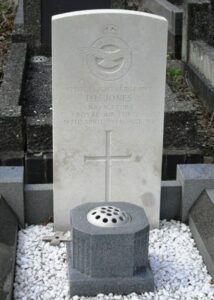
Edward Jenkin Jones, BA, Major, 129966, South Wales Borderers. Edward was the son of William David and Esther Elizabeth Jones, and the husband of Kathleen A. Jones, of St. Marylebone, London. He had been commissioned into the South Wales Borderers, and embarked for the Far East with the 6th Battalion, South Wales Borderers in October 1942, which trained in India as a tank regiment until March 1943, before being reconverted to infantry, and taking part in the Burma campaign. Edward took part in the famous capture of the Mayu Tunnels by the battalion, which then took part a nine month march into Burma. He was killed during heavy fighting at Sahmaw Chaung on 5 August 1944, aged 31, and is buried at Taukkyan War Cemetery, Burma.
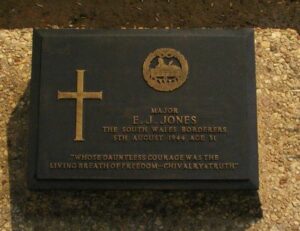
Edward Llewelyn Jones, Civilian Fireman, Romford Municipal Borough. Edward was the husband of Edith E. M. Jones, of 10 King’s Road, Romford. He was a fireman and was injured on 10 June 1943 at Hornchurch. He died at home at 10, King’s Road on 23 February 1946, aged 43. Edward is commemorated in the Civilian War Dead Roll of Honour, located near St. George’s Chapel in Westminster Abbey, London.
Evan Morgan Jones, Seaman, Merchant Navy. Evan was the son of John James Jones, Coal Merchant, of 6, Queen Street, Aberystwyth. He served with the Merchant Navy, and was home on leave when he accidentally drowned at Aberystwyth on 5 July 1942, aged 31. He is not commemorated by the Commonwealth War Graves Commission.
George Rowland Jones, Sergeant, 3909865, South Wales Borderers. George was the son of Thomas and Elizabeth Jones, of Aberystwyth. He served in the 2nd Battalion, South Wales Borderers. The battalion was the only Welsh unit to land on D-Day, landing at Le Hamel, near Arromanches on the Normandy coast at midday on 6 June 1944. In September the battalion was part of the force that was ordered to seize the port of Le Havre. Its task was particularly challenging, consisting of capturing three woods on a ridge heavily defended by the Germans with trenches, mines, concrete dug outs and wire. After two days of bitter fighting the Borderers had successfully achieved their objective and Le Havre was in Allied hands. Sadly George was killed here on 11 September 1944, aged 26. He is buried in Ste Marie Cemetery, Le Havre, France.
Gwilym Louis Gobert Jones, Second Officer, Merchant Navy. Gwilym, who was known as Louis, was born on 6 May 1916, the son of Lieutenant Gwilym Jones and of Margaret Jones, of Aberystwyth. He served with the Merchant Navy aboard the SS Tymeric, a Glasgow registered steamer. On the morning of 23 November 1940, Tymeric was in convoy OB-244, carrying a cargo of coal from Hull to Buenos Aires, when she was hit by a torpedo from the German submarine U-123, and sank in flames with the loss of 71 lives. Louis was 24 years old when he died that day, and is commemorated on the Tower Hill Memorial, London.
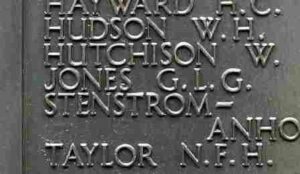
John Hubert Hughes Jones, Volunteer, Home Guard. John was the son of William David Jones, and of Elizabeth Jones, of Chepstow, Monmouthshire. He served with the 3rd City of London (Farringdon) Battalion, Home Guard. John died on active service on 9 September 1940, aged 34. He is buried at Penygarn Calvinistic Methodist Cemetery, Llandre.
John James Jones. John cannot presently be identified, but he was reported as missing during February 1945.
Stanley Jones, Driver, 14429117, Royal Electrical and Mechanical Engineers. Stanley was the son of Owen and Florence Jones, of Aberystwyth. Stanley was accidentally killed on 3 December 1943, aged 18. He is buried in Aberystwyth Cemetery.
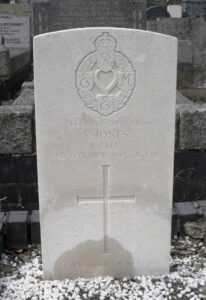
John Cyril Ladd, B.Sc., Corporal, 1190954, Royal Air Force Volunteer Reserve. John was the son of John and Decima Pickstock Ladd, of Cardigan, and the husband of Margaret Ladd. of Leicester. A B.Sc. Honours graduate he was a master at Ardwyn Grammar School between the years 1933–1938. He served with the Royal Air Force in North Africa, attached to the Desert Air Force, which supported the 8th Army during its war against Rommel in North Africa. John was killed in Libya on 7 March 1943. He was 32 years old, and is buried at Tripoli War Cemetery, Libya. John is not commemorated on the Ardwyn Memorial.
David Richard Doughton Lewis, Seaman, LT/JX 205200, Royal Naval Patrol Service. David was born on 25 March 1912, the son of Edward Thomas Lewis and Elizabeth Sarah Ann Lewis, of Aberystwyth. He married Frances Rowlands Davies in 1937, and the couple lived at 1, Laurels Place, Eastgate. David served with the Royal Naval Patrol Service aboard the mine sweeper HM Trawler Orfasy. During the night of 21 October 1943 Orfasy, whilst escorting the Danish tanker Litiopa, was heard to have fired two depth charges at the German U-Boat U-68, but was immediately hit by a torpedo which she had fired, and exploded, sinking with all hands, about 185 miles southeast of Freetown off the African coast. David was 31 years of age when he died on 22 October 1943, and is commemorated on the Lowestoft Naval Memorial, Suffolk. His brother, Dennys, was killed in 1941.
Daniel George Lewis, Leading Sick Berth Attendant, D/MX 49903, Royal Navy. Daniel was the son of John and Mary Jane Lewis, of Rhymney, Monmouthshire. He served at HMS Tamar during the war which was the Royal Navy’s shore base in Hong Kong. Hong Kong fell to the Japanese on Christmas Day 1941, and all of the military personnel there were taken into captivity. Daniel was 27 years of age when he died in captivity on 2 October 1942. He is commemorated on the Plymouth Naval Memorial, Devon.
Dennys Markham Lewis, Able Seaman, Merchant Navy. Dennys was the son of Edward Thomas Lewis and Elizabeth Sarah Anne Lewis of Aberystwyth. He served with the Merchant Navy, aboard SS Empire Heron, a London registered cargo steamer. On 15 October 1941, Empire Heron was in convoy SC-48, which was crossing the Atlantic on route to Manchester with a cargo of sulphur. Waiting in mid Atlantic was a German U boat pack, which attacked the convoy. Empire Heron was struck on the starboard side by two torpedoes fired by U-568, causing her to sink with the loss of 42 of her 43 crew. He was 23 years old, and is commemorated on the Tower Hill Memorial, London. His brother, David, was killed in 1943.
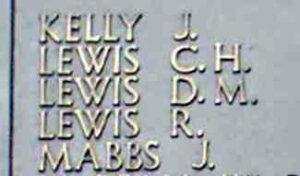
George Daniel Lewis, Sailor, Merchant Navy. Dan was the son of William and Margaret Lewis, of Aberystwyth. He served with the Merchant Navy aboard the SS George H Jones, a London Registered steamer. She had joined convoy SL-111 at Freetown and was carrying a cargo of fuel oil bound for the Isle of Arran. Sometime after leaving Freetown she was ordered to make for the Azores after developing engine trouble which forced her to drop out of the Convoy. On the morning of 11 June 1942, SS George H Jones was intercepted by the German submarine U-455 off the Azores, which torpedoed and sunk her. Nineteen crew and the captain were picked up and landed back in Freetown. A further 20 survivors were picked up and landed at Londonderry. Dan and a DEMS gunner were lost in the sinking. Dan was 24 years old, and is commemorated on the Tower Hill Memorial, London. Trevor Evans and Jack Sweeney of Llanon were ship mates of Dan’s, and both managed to get into a lifeboat. Despite a lack of food, water and shelter the pair were fortunately rescued two days later.
Tegwyn Mason Lewis, Lance Corporal, 14531306, Royal Armoured Corps. Tegwyn was the son of John and Elizabeth Lewis (nee Davies), of Ponterwyd. He served with “C” Squadron, 52nd (Lowland) Reconnaissance Regiment. The regiment arrived in Holland in September 1944 and its first action was Operation Market Garden, the attempt to take the bridges over the lower Rhine, Maas and Waal. He was 23 years of age when he was killed in action on 25 October 1944. On the same day the British 1st Airborne Division was evacuated following the failure to cross the Rhine in sufficient numbers. It remained a barrier until March 1945. Tegwyn is buried in Adegem Canadian War Cemetery near Antwerp in Belgium along with to two of his comrades in “C” Squadron killed on the same day; Troopers Frederick Heath and Charles James Purser. Tegwyn is also commemorated on his parents headstone at Ponterwyd.
John Powell Middlehurst, MID, Flying Officer, 41605, Royal Air Force. John was the son of Richard Foster Middlehurst and Dorothy Elizabeth Middlehurst, of Aberystwyth, and the husband of Joan Middlehurst. He served in 113 Squadron, Royal Air Force, during which time he was mentioned in despatches. During the summer of 1941, the squadron was based in north Africa and were equipped with the Bristol Blenheim. Duties ranged from strafing enemy convoys, bombing airfields and enemy harbours. On 2 July 1941 John was flying aboard Blenheim IV, Serial V5928, when it was shot down and crashed into the Mediterranean off Mersa Matruh, Egypt, killing all three of her crew. John was 21 years old when he was killed that day and is commemorated on the Alamein Memorial, Egypt.
Ronald Henry Morgan, Leading Aircraftsman, 1381382, Royal Air Force Volunteer Reserve. Ronald was the son of Henry George and Mabel Morgan, of Birmingham. He served with the Royal Air Force. On 16 May 1941, Ronald was flying aboard a Tiger Moth, Serial T5712 of 9 EFTS, when it hit a balloon cable and crashed at Walsgrave. Both Ronald and his pilot were killed. Ronald was 28 years old, and was buried with full military honours in Aberystwyth Cemetery.
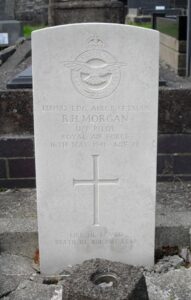
Herbert Orlando Peel, Pilot Officer, 116952, Royal Air Force Volunteer Reserve. Herbert was born at The Cottage, Llanilar in 1913. He married Doris Winifred Charleston, of 11, Bodwyn Park, Gresford, at Wrexham in 1942. Herbert was commissioned on 16 February 1942 as a Pilot Officer with the Royal Air Force, and was posted to 61 Squadron, Royal Air Force. The squadron was a bomber squadron, and flew with No. 5 Group, RAF Bomber Command, and by the time Herbert joined it, was equipped with the Avro Lancaster, after having just replaced its aging Manchesters. At around 23.00 on 2 September 1942, Herbert took off from RAF Syerston aboard Lancaster B1, Serial W4136, which was part of a large force sent to bomb a target in Germany. The Lancaster went missing on the following morning, probably after being shot down over the North Sea on 3 September 1942, with the loss of all of her crew of seven men. Herbert was 28 years old when he died that day, and is commemorated on the Runnymede Memorial, Surrey.
Ioan Wyn Richards, Able Seaman, Merchant Navy. Ioan was born at Dolgellau in 1920, the of John and Elisabeth Richards. He was raised at Aberystwyth, where his father was Station Master, before the family uprooted, and moved to Cardiff prior to the war. Ioan served with the Merchant Navy, aboard the SS Llanashe, a London registered Cargo Steamer. On 17 February 1943 she was on route from New York via Busreh and Bendar Abbas for Port Elizabeth, carrying a cargo of 3,500 tons of tin plate and aluminium, when she was torpedoed by the German submarine U-182 and sunk, with the loss of 28 lives. Ioan was 22 years old when he died that day, and is commemorated on the Tower Hill Memorial, London.
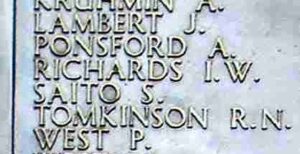
Gwen Seely. Gwen was 42 when she died in a German air raid on Coventry on 16 November 1940. She is not commemorated with the Commonwealth War Graves Commission.
Evan John Stephens, Sergeant, 967065, Royal Air Force Volunteer Reserve. John served with the 335th Fighter Group, Royal Air Force, which was based at RAF Steeple Morden, in Cambridgeshire. Evan was posted to No 11 Operational Training Unit for conversion training on the Vickers Wellington. On 24 August 1940 he was flying as air gunner aboard Wellington Ia, Serial N2945, which was on a night navigation exercise off the Isle of Man when the aircraft crashed into the sea off Bradda Head, killing all her crew of eight. Only four bodies were recovered. Evan was 20 years old when he died that night, and is commemorated on the Runnymede Memorial, Surrey.
Bryan Robert Thomas, Sergeant, 1051799, Royal Air Force Volunteer Reserve. Bryan was the son of Edward Campbell Thomas, of Briarley, Iorwerth Avenue, Aberystwyth. He served as a Wireless Operator/ Air Gunner with 142 Squadron, Royal Air Force. In 1941 the squadron was flying the Vickers Wellington, on strategic night bombing missions. At around 18.30 on 21 October 1941 Bryan took off from RAF Binbrook aboard Wellington IV, Serial Z1210, which was part of a force despatched to bomb Bremen. The aircraft failed to return from the raid the following morning and was presumed to have crashed into the North Sea. Bryan was 29 years old when he was killed on 21 October 1941. He is buried in Sage War Cemetery, Germany. The cemetery in made up of many airmen, most of whom were lost in bombing raids over northern Europe, who were brought in from other cemeteries after the war were for reburial.
Harold Thomas, Chief Officer, Merchant Marine. Harold was the son of Captain Thomas and Sarah Ann Thomas, of Aberystwyth. He served with the Merchant Navy aboard the SS Ocean Crusader, a British registered Liberty ship. On 26 November 1942, she was on her maiden voyage from Portland, Maine, to Avonmouth, UK, when she was torpedoed and sunk by Heinze Franke’s U -262 northeast of St John’s, Newfoundland. Due to heavy weather she was a straggler from the main convoy, HX-216, and went down with all hands on 26 November 1942. Harold was 43 years old, and is commemorated on the Tower Hill Memorial, London.
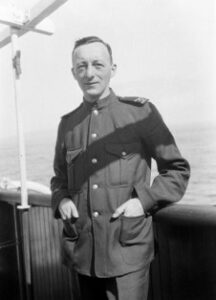
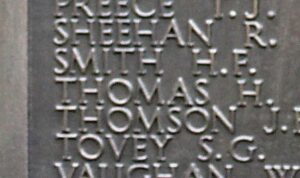
Richard Jarvis Vaughan, Flight Sergeant (Air Bomber), 1410538, Royal Air Force Volunteer Reserve. Richard was born in 1916. He served with 70 Squadron, Royal Air Force, which was equipped with the Vickers Wellington Bomber. Richard was killed when his Wellington X, Serial LP267, was lost over Germany on 7 July 1944, with the loss of all five of her crew. He was 28 years old, and is buried at Klagenfurt War Cemetery, Germany.
Edward Hammond Whitehouse, Flight Lieutenant, 42035, Royal Air Force. Edward was the son of Wallace Edward and Mabel Whitehouse, of Aberystwyth. He served as a Pilot with 264 Squadron, Royal Air Force, which was reformed on 8 December 1939 at Martlesham Heath, to bring the Boulton Paul Defiant fighter into service. Operations began in March 1940 when the squadron started convoy patrols. After initial successes the Luftwaffe soon realised that the Defiant was vulnerable to frontal attack, and the squadron started to have heavy losses of aircraft and crew. Edward was killed when his Defiant Mark I, Serial L6959 was shot down by a Messerschmitt Me109 on 28 May 1940. He was 24 years old, and is commemorated on the Runnymede Memorial, Surrey.
Kenneth Jarratt Wilkinson, Bombardier, 927666, Royal Artillery. Kenneth was the son of Charles Richard and Florence May Wilkinson, of Aberystwyth. He served with 146 (The Pembroke Yeomanry) Field Regiment, Royal Artillery. The 146th Field Regiment was raised in Cardiganshire, and joined the Eighth Army in time to take part in the Battle of El Alamein. Afterwards it became part of the 7th Armoured Division, taking part in the advance to Tripoli, and helping defeat Rommel’s counter-attack at Medenine. The Regiment fought with the Desert Rats until the fall of Tunis in May 1943. Kenneth was killed here on 8 May 1943. He was 21 years old, and is buried in Massicault War Cemetery, Tunisia.
David Edwin Williams, Chief Engineer Officer, Merchant Navy. David was born in Talgarth, Breconshire on 27 July 1891, the son of Edwin and Olivia Williams. His father died in 1903 and his mother moved the family to Aberystwyth, where David was educated at Ardwyn. The family then moved to Barry, where David began an engineering apprenticeship with the Mercantile Marine. Following the outbreak of the Great War, he enlisted into the Royal Flying Corps. He went back to sea after the war and by the outbreak of WW2 was serving aboard the Liverpool registered steamship SS Haig Rose. On 5 November 1940 Haig Rose steamed from Barry for Plymouth, but was never seen again, disappearing with all seven of her crew. David was 46 years old when his ship went missing, and he is commemorated alongside his fellow crew on the Tower Hill Memorial, London.
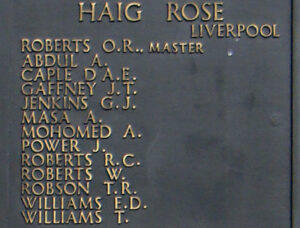
Enoch Gwynfryn Williams, Sergeant, 1582620, Royal Air Force Volunteer Reserve. Enoch as the son of Thomas and Mary Williams, of Borth, and the husband of Joyce R. Williams, of Whitmore Reans, Wolverhampton. He served as a Navigator with the Royal Air Force. Enoch was killed when his aircraft, an Avro Anson, Serial NK890, of 60 Operational Training Unit, crashed during a training exercise in Shropshire on 13 January 1945, killing all four of her crew. He was 25 years old, and is buried at Wolverhampton Borough Cemetery, England. Enoch is not commemorated on the Ardwyn Memorial, although he was reportedly educated at the school.
Enoch Jones Williams, Sergeant, 1130519, Royal Air Force Volunteer Reserve. Enoch was the son of Thomas and Rebecca Williams, of Blaenrhondda, Glamorgan. He served as a Flight Engineer with 78 Squadron, Royal Air Force. The squadron was part of Bomber Command, and was equipped with the Handley Page Halifax heavy bomber. Enoch took part in the squadrons famous raid on the Germans rocket development plant at Peenemunde. He was killed when his aircraft, Halifax Mark II, Serial JD-406, was shot down over France on 28 August 1943. Enoch was 22 years old, and is buried in Souilly Churchyard, France, along with five other members of his crew.
Howard Lloyd Williams, Quartermaster, Merchant Navy. Howard was the son of Richard and Mary Williams, of Borth. He served with the Merchant Navy aboard the MV Abosso, a Liverpool registered ocean liner. On 29 October 1942, Abosso was on voyage from Cape Town to Liverpool, when she was attacked and sunk by the German submarine U-575. Only 31 people survived the sinking, out of around 182 crew, 20 gunners, and 190 passengers aboard. Howard was amongst the dead that day. He was 25 years old, and is commemorated on the Tower Hill Memorial, London. This was the second time that Howard had come under attack by a German U boat. On 11 March 1941 he was aboard the unescorted MV Memnon (Liverpool) homeward bound from Australia when she was sunk by U-106 about 200 miles off the Africa coast. A single torpedo on the starboard quarter sent her to the bottom inside 12 minutes with loss of five men out of a crew of 50. Howard’s lifeboat of 21 survivors was adrift for ten days before landing north of Dakar.
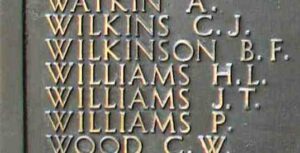
Ivor Williams. Ivor appears to have died in February 1946, and was formerly a POW. He cannot presently be identified.
James Worrall Williams, Sergeant, 1285053, Squadron Royal Air Force Volunteer Reserve. James was the son of James Worrell Williams and Louisa Williams, of Llanbadarn, and the husband of Rosina Jane Williams, of Newbiggin-by-Sea, Northumberland. He served with 101 Squadron, Royal Air Force, which was a heavy bomber squadron, equipped with the Avro Lancaster. James was killed in action when his Wellington III, Serial X3669, was shot down by a German fighter and crashed into the North Sea, killing all her crew of seven on 20 June 1942. He was 21 years old, and is commemorated on the Runnymede Memorial, Surrey.
John Rodd Williams, Sergeant, 1836168, Royal Air Force Volunteer Reserve. John was the son of Arthur and Agnes Williams, of Islwyn, Talybont. He served as a Flight Engineer with 158 Squadron, Royal Air Force, which was a heavy bomber squadron, equipped with the Handley Page Halifax. At just after 09.00 on 24 March 1945, John took off from RAF Lissett aboard Handley Page Halifax Mk III, Serial MZ759, which was part of a force bound for Gladbeck. The Halifax was shot down and crashed near Gladbeck, killing four of her crew. Three survivors were taken prisoner of war. John was 20 years old when he died that day, and is buried at Reichswald Forest War Cemetery, Germany.
George Henry Wynne, Sergeant, 847519, Royal Air Force (Auxiliary Air Force). George was the son of Edward Price Wynne and Emma Gertrude Wynne, of Trefechan, Aberystwyth. He served with the Royal Air Force as a Navigator. George was one of three men who were killed when their Vickers Wellington IC, Serial R1272 crashed into the Grampians whilst on a night navigation exercise from RAF Lossiemouth on 4 August 1942. He was 30 years old, and is buried in Lossiemouth Burial Ground, Scotland.
John Frederick Owen Yateman, Leading Aircraftman, 1256684, Royal Air Force Volunteer Reserve. John was the second son of Frederick and Elizabeth Yateman, of Sway House, Sway, Hampshire. He served in the Royal Air Force during the war and was based in the Far East. He was taken prisoner by the Japanese after the invasion of Malaya in December 1941, and was one of thousands of Allied POW’s who were shipped by ‘Hell Ship’ to Japan, to be used as forced labour. John died in captivity at Zent Suiji Camp on 7 January 1944, aged 21, and is buried in Yokohama War Cemetery, Japan. The photograph is courtesy of Tony Beck.
